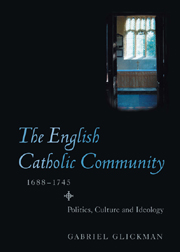Book contents
- Frontmatter
- Contents
- List of illustrations
- Acknowledgements
- Abbreviations
- Introduction
- 1 English Catholics and the Glorious Revolution of 1688
- 2 The making of the Catholic gentry in England and in exile
- 3 Conscience, politics and the exiled court: the creation of the Catholic Jacobite manifesto 1689–1718
- 4 Catholic politics in England 1688–1745
- 5 Unity, heresy and disillusionment: Christendom, Rome and the Catholic Jacobites
- 6 The English Catholic clergy and the creation of a Jacobite Church
- 7 The English Catholic reformers and the Jacobite diaspora
- Conclusion
- Appendices
- Bibliography
- Index
6 - The English Catholic clergy and the creation of a Jacobite Church
Published online by Cambridge University Press: 12 September 2012
- Frontmatter
- Contents
- List of illustrations
- Acknowledgements
- Abbreviations
- Introduction
- 1 English Catholics and the Glorious Revolution of 1688
- 2 The making of the Catholic gentry in England and in exile
- 3 Conscience, politics and the exiled court: the creation of the Catholic Jacobite manifesto 1689–1718
- 4 Catholic politics in England 1688–1745
- 5 Unity, heresy and disillusionment: Christendom, Rome and the Catholic Jacobites
- 6 The English Catholic clergy and the creation of a Jacobite Church
- 7 The English Catholic reformers and the Jacobite diaspora
- Conclusion
- Appendices
- Bibliography
- Index
Summary
The taint of a ‘priest-ridden’ reputation bedevilled the Jacobite movement. Whispers of shadowy clerics directing secret counsels filtered into the descriptions of St Germain, circulated by Williamite agents within England to fan the flames of the popular imagination. Accounts of Stuart conspiracies claimed to expose the craft of James II's ‘fatal scorpions’, who ‘swarm'd over from Doway and St Omers, greedily gaping after preferments’. Jacobitism gave a new lease of life to old archetypes of Catholic clergymen as exotic figures, inspired by the missionary and martyrological zeal of the Counter-Reformation to hold up a crucifix to Protestant England. This chapter will aim to explore the reality behind these judgements, investigating the connection between the English Catholic clergy and the dynastic contest to produce a political reading of recusant ecclesiastical history in the early eighteenth century. I will argue that, although the Stuart cause did not breed religious extremism among the priesthood, it injected new political zeal into their ranks, enough to change the priorities of the domestic mission. Ambitious émigrés used the cloth, the cowl and the mitre to advance dynastic service in the corridors of the ancien régime, and formulate a new modus operandi that could unite devotion to order, faith and king in the defence of ‘our afflicted church, which has suffered so long under an unjust usurpation’ as John Ingleton described the struggle.
The study of an active clerical Jacobitism calls into question the existing scholarly depiction of Georgian Catholicism, with its stress on the drift into an insular, denominational status that banished any longing to revive the ‘ghost church’ of pre-Reformation England.
- Type
- Chapter
- Information
- The English Catholic Community, 1688–1745Politics, Culture and Ideology, pp. 191 - 220Publisher: Boydell & BrewerPrint publication year: 2009



